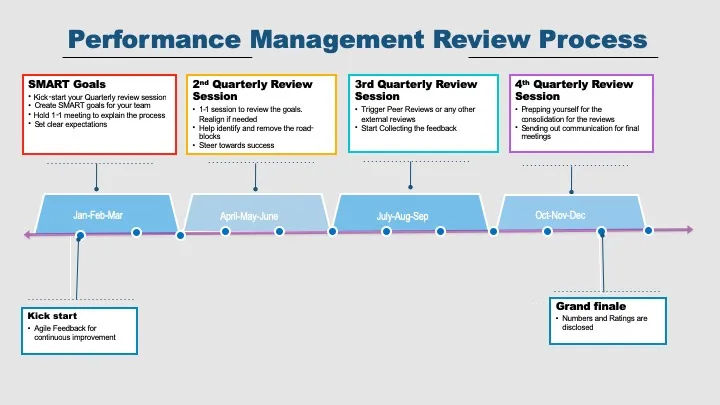ClayHR Annual Conference: Shaping Work 2026 | Feb 20, Accra → Learn More

The experts who study the correlation between organizational behavior or employee engagement and agile performance review management system, strongly advise planning a performance review program that is year-round and not just limited to one interaction or a few sessions crunched in a short duration.
They explain that having a one-time performance review session or even one-quarter long performance review session may create an environment of dissatisfaction rather than creating a conducive environment of growth and appreciation. The general guideline by the experts is to backtrack your final review session by at least 12 months to allow sufficient time to set individual and corporate goals, tie the goals to the performance metrics and to provide sufficient time to the team members to achieve these goals.
RELATED ARTICLE: HOW TO WRITE A GREAT PERFORMANCE REVIEW?
The whole of the performance review process should be treated as a year-long activity and planned well ahead of time. The planning will not only help you roll out a structured process but also, in the end, deliver more comprehensive feedback and when review season rolls around, there will be no surprises for you or your employees—and that’s what you should be striving for.
This concept is against the annual review process which was performed once a year with the employee and the session usually included the promotion news, bonuses, rewards, and feedback all clubbed into one! Slowly this system is fading away because of a couple of reasons:
Smart workers won; hard workers lost! – It was observed that because of this process, the smart people started performing when it was time for the reviews, they impressed their managers with their latest project and gained appreciation. On the other hand, employees that worked hard throughout the year carried the overall belief that they were not appreciated enough.
Feedback delayed is of no use! – It was also observed that if feedback was given even a month after the event, it seemed irrelevant or lost the required impact. Real-time feedback or check-ins provide ample opportunities to both the parties to discuss and evaluate the scenario and analyze what went right and what went wrong or explore what are the options available to bring it back to track.
The choice to select the month for conducting the performance reviews is driven by many factors such as:
Your organization’s accounting cycle: This is critical if you would like to pay-out the bonuses in the same fiscal year as the review. So if the financial closing is on Dec 31st, then ideally the reviews should conclude by October 31st and pay-outs scheduled by November.
Your organization’s work-intense season: You would not like to conduct the reviews when the employees are most busy as it can be a cause of a major distraction.
A survey conducted in 2019, on 500 different organizations varying from 150 to 2000 employees, showed that employee confidence level in the organization jumped by 67% after they introduced consistently paced review process.

Now, for the sake of ease, let’s say your review season will be at the end of the year, in December. Here’s what experts in the performance review process suggest the schedule should look like:

Once you have finalized the timeline, it is also time to think through the process of actual Conducting the Performance Reviews.
As shown in the timeline above, when it comes time for performance reviews, there is a general 5-step process many organizations follow:
RELATED ARTICLE: HOW TO WRITE SMART GOALS WITH ClayHR